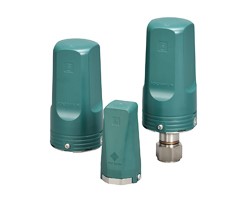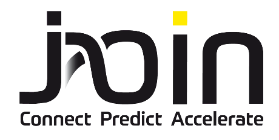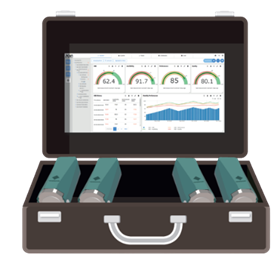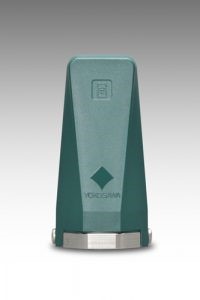New times call for new ways of working. Many changes are also taking place within the process industry. Remote communication is now more important than ever. The Industrial Internet of Things (IIoT) makes it possible for machines, robots, and smart sensors to communicate wirelessly with each other. The generated data improves maintenance processes and improves plant efficiency. In 2019, Yokogawa launched the first smart sensor in Europe – the Sushi Sensor. Recently two new variations have been added – a wireless temperature sensor and a wireless pressure sensor, which simplify the online collection of temperature and pressure data. Smart Sensors collect useful data during the plant processes. But how do they contribute to predictive maintenance? We conducted an interview with Bart van Haagen, a specialist in the field of field instrumentation and smart sensors.
25+ years of experience with smart sensors
This year, Bart van Haagen (Business Unit Marketing Manager at Yokogawa Europe) will be working for Yokogawa for 34 years. Bart works at Yokogawa Europe’s headquarters in Amersfoort, the Netherlands. With a background in process control, such as controllers and DCS systems, Bart previously worked mainly with the smaller systems such as the STARDOM. Later he was transferred to the Process Control Instruments (PCI) department, where he has gained over 25 years of experience in the field of field instrumentation, including smart sensors.
Conservative industry
Bart completed his studies at TU Delft in the 1990s. Back then, he already predicted that big changes will take place in the industry.
“New ideas emerged at the time, but the industry was still quite conservative. Gradually we’re seeing those ideas being adapted in the industry now – that’s 30 years later!”
Bart recognizes many concepts from the past, such as the term ‘smart sensor’ which in fact emerged years ago.
“When I joined Yokogawa, we were already talking about a smart sensor. The intelligence transfers from the top to bottom in the industrial automation pyramid. In the past, sensors were not considered ‘smart’ – they only had one signal, so the ‘smart’ part was mostly in the DCS system. At that time, customers had no idea what they could do with all the data”.
Enabling predictive maintenance with smart sensors
Smart sensors play a crucial role in the maintenance of the future. Predictive maintenance improves uptime. Downtime as a result of unnecessary maintenance or defects is reduced, while the maintenance work that is needed can be planned in advance. Bart enjoys working with new, challenging concepts. This is exactly the case with the new Yokogawa IIoT sensor – Sushi Sensor – which was officially launched in Europe in 2019. It is a small, compact, wireless device equipped with scanning and communication functions and has been specially developed to detect vibrations, surface temperatures, and pressure data from plant equipment.

“When we introduce the Sushi Sensor to customers, their eyes widen because that’s exactly what they’re looking for.”
More than just a sensor
Simultaneously, many plants are struggling with a shortage of technical staff. Bart stresses that now is really the time for a change in the way we work with sensors and data. That is exactly what Yokogawa’s IIoT program JOIN achieves – making all collected data usable.

Hence, the open IIoT program JOIN offers a total solution of consultancy, cloud, network, and sensors. By offering an all-in-one solution, field operators do not have to be bothered with maintenance issues and can focus on the real work. “In the past, there were large instrumentation departments where people were responsible for all maintenance work themselves, but these don’t exist anymore. Nowadays in many cases, there is only have a maintenance engineer or manager left, but they don’t have time for this. That means we must take matters into our own hands,” says Bart.
Leave the guesswork out of maintenance
Although there was a strong demand for smart sensors after the first launch of the Sushi Sensor in 2019, Bart noticed that there are also organizations that do not fully understand the urge for maintenance. He explains:
“There are still thoughts like ‘It costs a lot’, ‘Is maintenance really necessary?’ ‘Can we postpone it?’ But then something breaks down causing a huge problem that comes with a high price.”
Some companies even take everything apart every couple of years to repair something, while later it turns out that it wasn’t necessary at all. Many maintenance engineers are glad about the idea of a smart sensor and open IIoT platform – they can show management that costs can be saved as long as maintenance is predictive.
“There is a first in everything”

“Some customers are still afraid of the cloud, while they don’t even notice that they are already working in the cloud.”
Bart hopes that this will change.
“For many companies it’s new, but there is a first in everything: try it out and discover the benefits”.
He indicates that management should also understand the importance of Industry 4.0 and that plant managers should be aware that you can do much more with the collected data.
Certainly, the main question remains: where do you start? Recently Yokogawa has developed new Starter Kits for IIoT and predictive analysis. They are ideal to run a pilot predictive maintenance on different assets such as heat exchangers and rotating equipment.
The ‘next big thing’ in the process industry
What about the future of the industry? Bart thinks of one thing: the use of data. The industry has to learn how to make good use of the data, such knowledge should be made good use of.
“Many people like myself are retiring soon. If you don’t retain the knowledge, eventually it will be lost”.
More information or questions?
The IIoT is changing business and a rising trend, especially during current uncertain times. Activities that used to be ‘only possible on-site’ are now supervised from remote. The convergence of information technology and operational technology (ITxOT) plays a major role in this transformation. This also means that we must adapt to new technologies. Do you have questions about the Sushi Sensor or the JOIN program? Contact us here or follow JOIN on LinkedIn.
Related Products & Solutions

JOIN: An Integrated IIoT Program
JOIN is an open, collaborative IIoT program that offers a complete value chain from consultancy, data collection, connectivity, cloud, predictions, and dashboards. It is an all-in-one IIoT platform of solutions and services developed by Yokogawa and Perfact Group, providing comprehensive IIoT solutions for business automation in diverse industries. JOIN has three main pillars: Connect, Predict, Accelerate.
.




